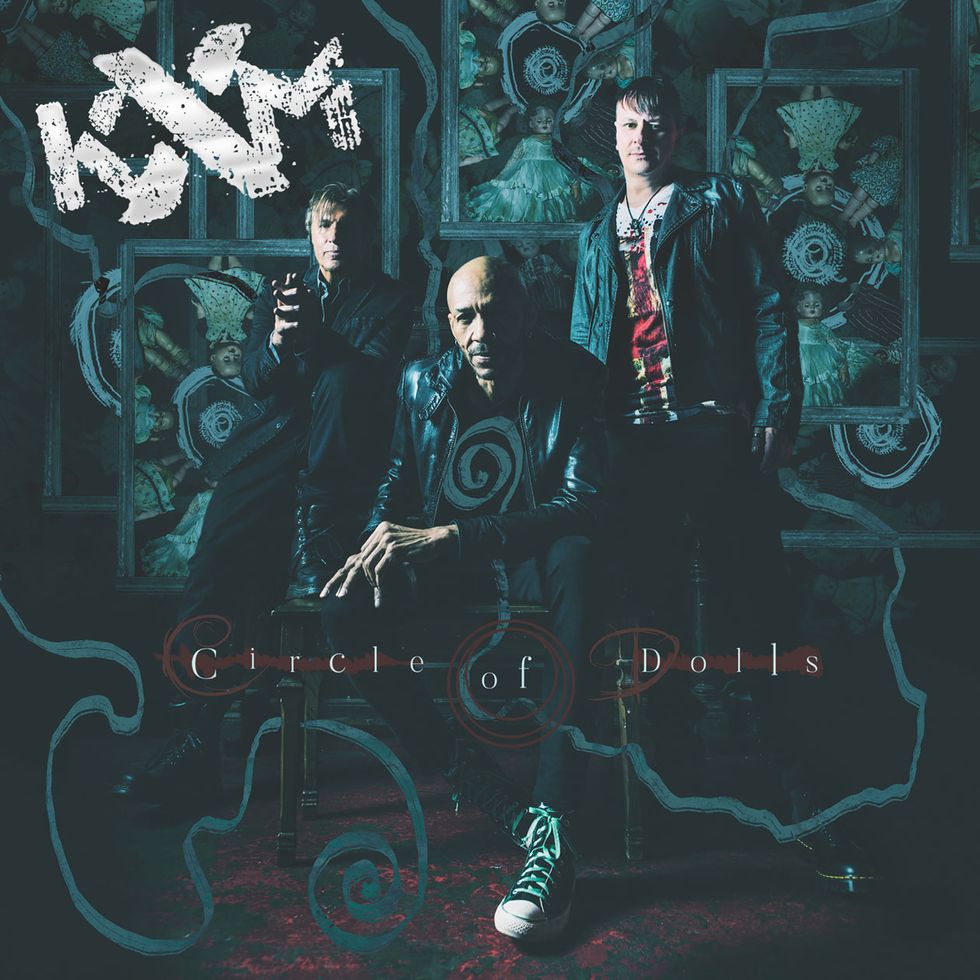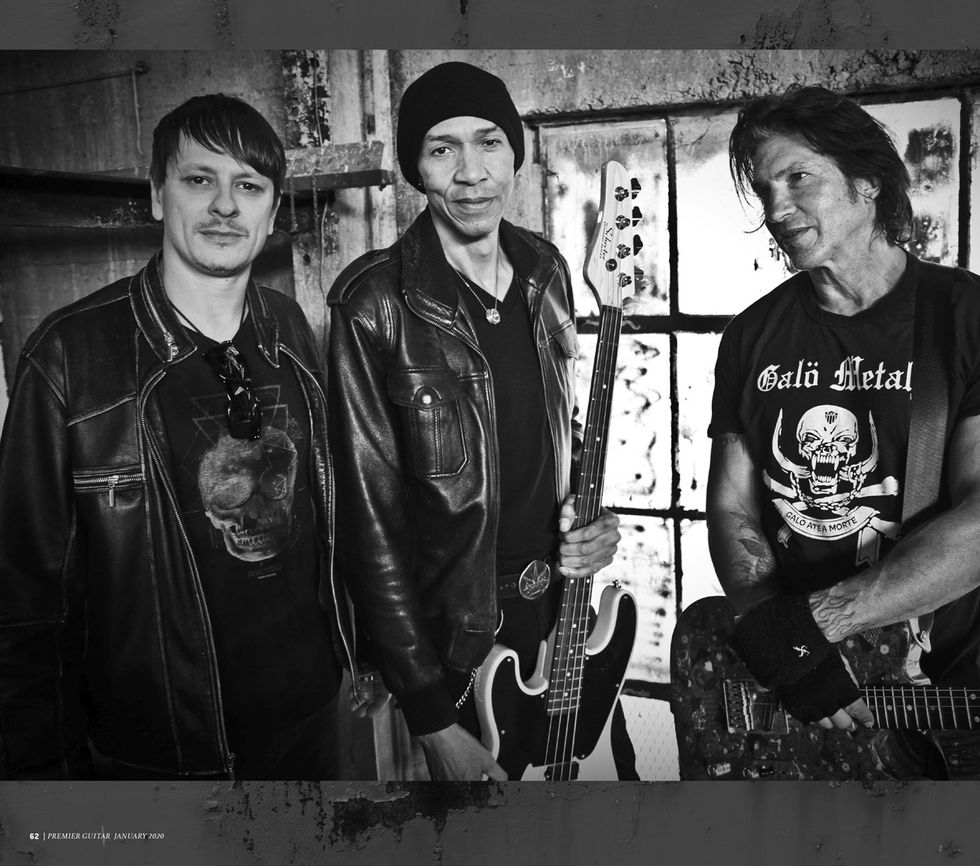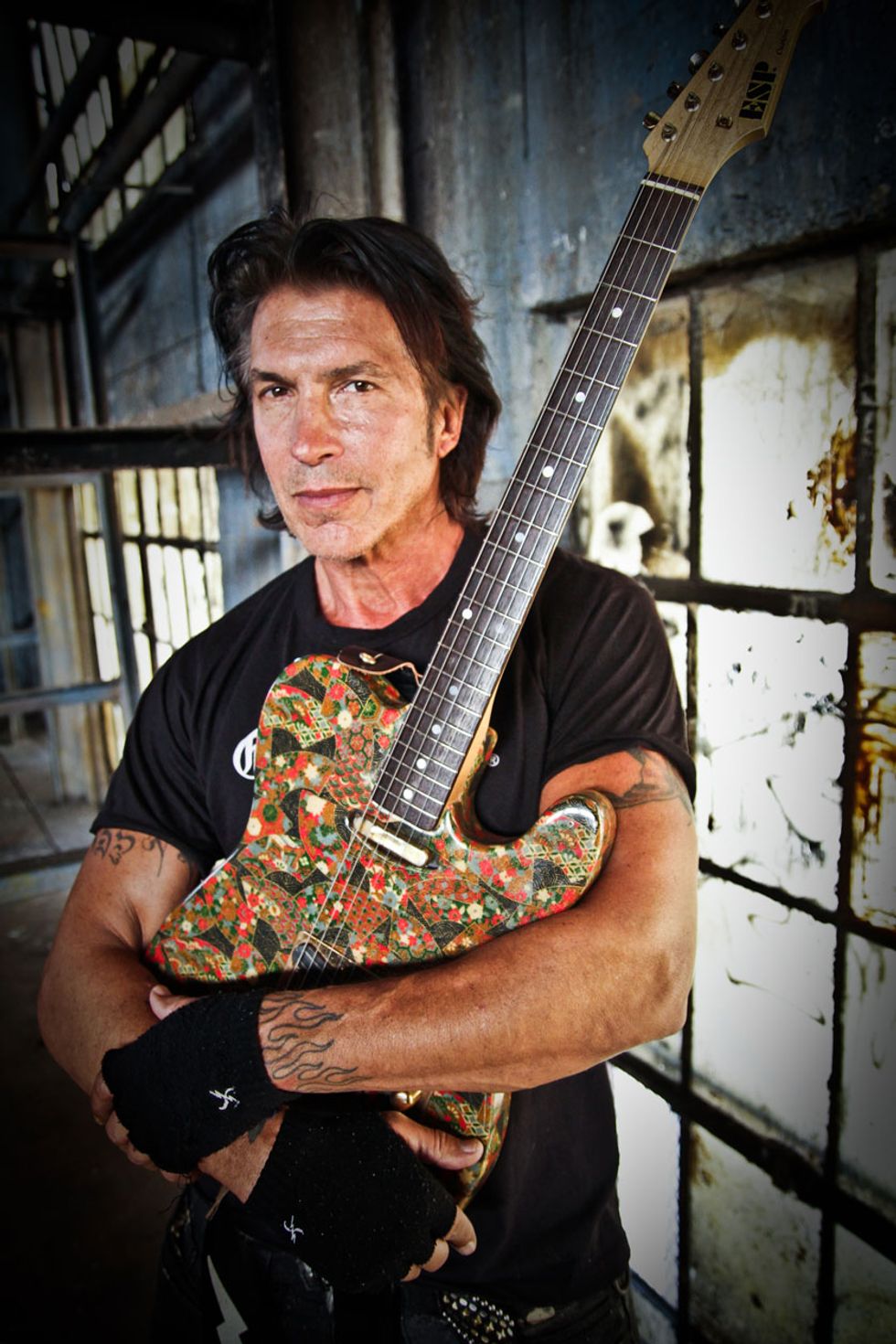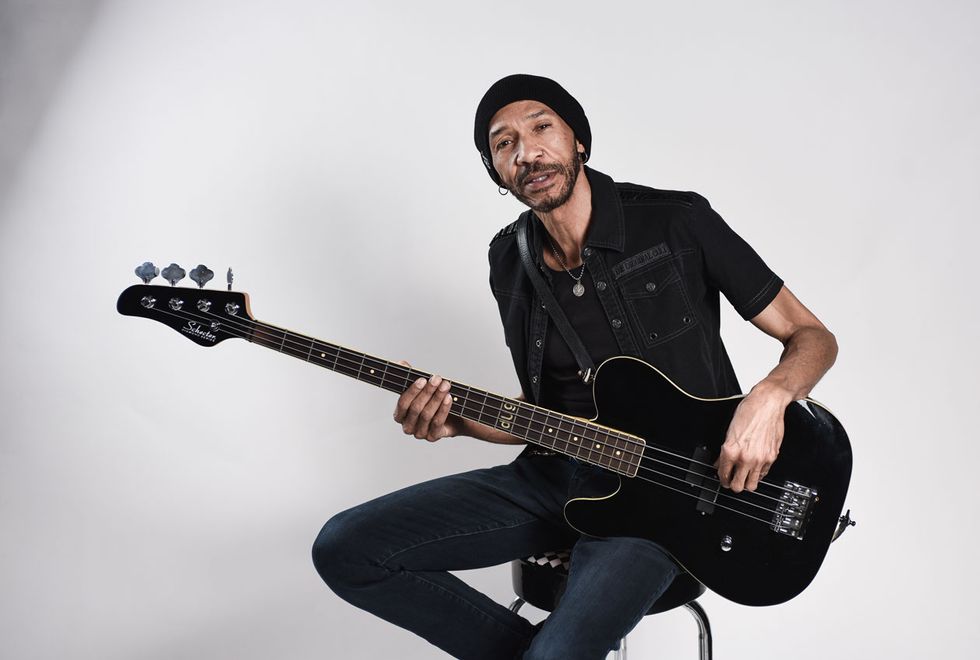When George Lynch phoned for our interview, he was in his car making the rounds through the maze of warehouse complexes where famous guitar-gear gurus are sequestered away in the corporate parks of North Hollywood, California. First, Lynch was headed to drop off a vintage Vox Clyde McCoy wah for some TLC by Way Huge’s circuit-wizard Jeorge Tripps. Then it was off to the guys at Arcane Pickups to collect a custom order.
“I’m down in that gear epicenter in Burbank three times a week taking care of stuff,” says the veteran guitar hero. It’s kind of like my commute—it almost feels like you actually have a job.” Despite his gripes about the morning trudge, Lynch claims it’s his passion for gear that’s kept him inspired after so many years in the music business. “You know why I love Premier Guitar? You guys love gear. I realized recently I’ve never been that interested in theory or a lot of the other things most guitar players are enamored with. But gear—I’m so batshit about it! To me, that’s what keeps it exciting after playing for almost 55 years. The gear keeps it fresh, almost more than the playing aspect.”
That’s no surprise, given Lynch’s penchant for amassing signature model gear, included ESP guitars (he was the first ESP signature artist), Randall amp heads, and various pickups, strings, speakers, and amp switchers—all stuff Lynch has put to good use over the years. Since emerging as one of the highest profile players of the ’80s gunslinger class with Dokken and then his own group, Lynch Mob, he has lent his talents to many projects. But unlike the lion’s share of these, his power trio KXM—which features Korn drummer Ray Luzier and King’s X singer and bassist dUg Pinnick—has kept his attention for nearly six years and three LPs.
During PG’s morningride-along through Los Angeles’ sprawling gear labyrinth, Lynch opened up about KXM’s new album, Circle of Dolls, the joys and challenges of the band’s creative process, and the hallowed gear he employed on the album. Circle of Dolls reveals unexpected sides of Lynch’s playing, including slide guitar, understated solos, and creative soundscapes that might take casual fans of Mr. Scary’s work by surprise, but are ideally suited to KXM’s sound.
For previous albums, KXM crafted songs through improv jams. Is that how you approached Circle of Dolls?
Yes, absolutely! For this album we gave ourselves 12, 12-hour days to write and record 12 songs—not including vocals because dUg does them afterwards. Each song was finished within one day, including overdubs and solos. That’s a lot of work when you’re starting from scratch. You may spend the first half of the day just coming up with the concept and building the arrangement, then rehearsing it so that it’s in your bones enough to play convincingly. If 7 o’clock rolls around and a song still isn’t really working, you’re in a corner and have to come up with a way to make it work. We’ve had some instances where we’ve wished we would’ve spent a little more time on something, but dUg always brings up a valid point: The defining feature of this band is the process and if we did things the traditional way, it wouldn’t really be KXM.
What I’ve always loved about being a musician is that moment when something is conceived. It’s such an exciting moment. The creative process is a mysterious thing to me and the idea behind KXM, and any improv-based music, is that you’re sharing the exact moment that something’s being created with the audience. But it’s hard to capture that moment. I don’t think there are any true jam bands, at least that I know of. I’m a fan of the genre and not to take anything away from bands like Umphrey’s McGee and Phish—they’re insane and I love them—but to me, it’s not really improvised on the spot. There’s usually a safety net to it in some sense, but when a guy like Hendrix would improvise, he was doing a musical high-wire routine without a net. I miss that.
How do you approach that high-wire routine with KXM?
This band is completely unorthodox for me. I’m used to being in bands that do pre-production with written songs and we don’t do any of that. Also, while dUg and Ray are rock guys, they’re unorthodox players. Ray is this ambidextrous, tribal, almost symphonic drummer and dUg has a very unique style. They both present challenges that I love and that force me out of my box. Not in a huge way—it’s still rock music—but odd time signatures, soundscape stuff, and non-traditional changes all present challenges. I love having to push myself out a little further in different directions while staying true to my thing.
—George Lynch
I find it very, very difficult these days to record music in a human and honest way. The pursuit of perfection has become so ingrained in how we record now and in the new technology that it becomes sterile. If you’ve ever listened to some of the individual tracks from classic bands like Hendrix, Zeppelin, or Van Halen, so many of the final takes on legendary records have “imperfections” all over them—in a good way! I just laugh and think, “how beautiful and imperfectly perfect it is when it’s all put together.” Bad notes, out-of-tune guitars, voices in the background, amps buzzing away—but it’s okay. It makes it human and so much more interesting.
Describe your core signal path on the new album.
I started out with five amps and I kept swapping one or more out as needed: a ’68 50-watt Marshall plexi, which is my main head these days, a ’71 Park 75 with KT88s, a Bogner-modified early-’80s Marshall JCM800, which has an incredible amount of usable gain, a Trainwreck, and at the end I was using a Mezzabarba for some rhythm parts.
I run everything through vintage cabinets. I used my ’70s Hiwatt 4x12 loaded with purple-back Fanes. I love Hiwatt cabs from that era because they’re ported and overbuilt with 16-ply birch. Those vintage 50-watt Fane speakers do a thing that vintage Marshall cabs don’t. They handle more power, so they don’t break up as easily, but they still get a very pleasing and even breakup. They’re more articulate. I also used an old Orange cabinet loaded with pre-Rola Celestions, which is darker sounding and works great with amps like the Trainwreck or anything that you want a little more low-end beef from. The last cab I used was an old salt-and-pepper basketweave Marshall 4x12 from the ’70s. It’s a little looser sounding and has two British-made Celestion Heritage Greenback 20-watt speakers and two Celestion G12H 55s—the speakers Hendrix preferred. The Greenbacks and the G12Hs are in an X pattern, and I mike them up independently and mix them together.

TIDBIT: The trio takes its name from the members’ main bands: Korn, King’s X, and Lynch Mob.
Is the Trainwreck an original Ken Fischer-made amp?
It’s an original. Ken made me one in the very early ’90s. It was the Express—his Marshall-type thing. I wasn’t really enamored with it, plus he names each amp and I was supposed to have my then-youngest daughter’s name on it but he got the name wrong. He called that one Suzanne. Between the name and it not being my taste as far as Marshall-type amps go, I sent it back. He made me a Liverpool, which is his Vox AC-30-type circuit and really his bread-and-butter. I like using it with another amp. I was touring with it for a couple of years along with a Marshall or a Park, and it’s wonderful like that.
Which guitars did you find to be the most inspiring for Circle of Dolls?
I had three main guitars. I generally like to use something with a fatter sound for my first track, which is the most critical track because it’s the one I’m going to play everything along with after. ESP had made a clone of a ’burst Les Paul that I borrowed to use for an instructional video back in the ’80s. I couldn’t get that guitar, but they had the Japanese custom shop make me an exact replica of it, and that’s what I used for the first track. It has that low-end Les Paul chunk that takes up a lot of sonic space. I layered that sound by doing overdubs with a guitar ESP made me that’s very much like a vintage Tele, but it has the bridge pickup slanted the other way, so it’s not quite that twangy country thing. It’s got more of a rock sound, even though it has a traditional Tele-style Lollar pickup. Those two are what I used for 75 percent of the rhythms.
Typically after I have those two main rhythm guitars tracked, I’ll embellish that with a lot of other stuff. I have a really wonderful ESP electric 12-string that I’ve used on every KXM record. The solos could be almost anything, but I used my ESP Skull ’n’ Snakes signature with a Sustainiac on it a lot, as well as my ESP Kamikaze signature.
I also used various tunings. A lot of it is a half-step down, though sometimes I’ll drop tune the low string when I’m a half-step down. Sometimes I used DADGAD and sometimes random tunings I didn’t even document and have no idea what they were. I’ll have to figure them out again by ear.
How did you get the moody, atmospheric sounds on tracks like “Big As the Sun” and “Mind Swamp”?
It was all done during tracking and I relied heavily on a mid-’70s Mu-Tron Octavider. I bought my original one new in the ’70s and bought a couple backups since. Any time you hear that really distorted monster octave sound, it’s that. For the more atmospheric stuff, I used my Sustainiac, which I have built into a guitar, as well as a couple of pedal versions from the ’80s.

Guitars
ESP Japan Custom Shop 1959 Les Paul-style ESP Custom T-style ESP “Skulls & Snakes” Signature Model ESP Custom 12-string Electric
Amps
Original Trainwreck Liverpool
’70s Park 75
1968 Marshall 50-watt Plexi
Mezzabarba 100-watt MZero Overdrive
Early-’80s Bogner-modified Marshall JCM800
’70s Hiwatt 4x12 loaded with 50-watt “purple back” Fanes
’70s Orange 4x12 loaded with “pre-Rola” Celestions
’70s Marshall 4x12 loaded with two Celestion Heritage G12M Greenbacks and two Celestion G12H 55s
Effects
’70s Mu-Tron Octavider
’70s MXR Phase 90
Silver Klon Centaur
’80s Ibanez TS-808 Tube Screamer (with Malaysian-made RC4558P chip)
Strymon blueSky
Hughes & Kettner Rotosphere
Morley George Lynch Tripler
Framptone 3-Banger
Strings and Picks
D’Addario Pure Nickel Superlight Plus (009.5–.044) on 25.5"-scale guitars
D’Addario .010 sets for 24.75"-scale guitars
Dunlop Jazz III Eric Johnson 1.38 mm
My overdrive on most things is a silver Klon Centaur or a second-year, Malaysian-chip Ibanez Tube Screamer. What I’ve been doing lately is stacking the Klon and the Tube Screamer together. You might expect that to be too bombastic and blown out, but it’s not at all. If you set them each lower, it doesn’t give you that much more gain, but they fill in each other’s EQ gaps. You get the mid-bump from the Tube Screamer but, with the Klon added, you don’t lose the low end like you normally do. I also use my signature Tripler amp switcher, which is the only one I’ve ever found without any tonal degradation.
Was there anything specific you wanted to lean into as a guitarist for Circle of Dolls?
I’ve never looked at KXM records—or really most records that I do—as vehicles for me for guitar solos or anything like that. I’m much more excited about writing a song and having the overall album and the sound of the band having an impact. I wish I could give myself credit for having some sort of grand vision, but our music is really just a reaction to playing with each other and whatever comes from an initial spark—which could be anything. KXM has a very democratic and equally split workload—we all come up with some solid piece to anchor the thing and we build around it. We never want it to be too traditional or expected, we want it to shake you up a bit and be slightly challenging, but not completely alien and weird. That’s how we think as a band.
Your solos on the album sound like songs within songs, and often play off the melodies.
It’s funny, there’s been a bit of a negative response to the solo for “Lightning” from journalists and in comments. While I don’t care either way, the criticism has been that the solo is too laid back and understated. Again, my focus is to serve the song and I think that solo did that. It was supposed to be very moody, dark, and melodic—like the rest of the song. It’s beautiful and haunting to my ears and I love it, so I’m not sure I even understand my audience anymore.I actually had a solo at the end where I really went off, but I cut it from the song because I felt like it was going on too long and self-aggrandizing.
What does dUg’s playing bring out in you as a guitarist and songwriter?
What initially freaked me out about dUg’s playing was that he plays counterpoint. He doesn’t always play a part that parallels and mirrors the guitar like bass does in a lot of traditional rock music. A lot of the time, dUg plays a part that’s complementary, but very different from what I’m doing. It can inspire me to try and follow what he’s doing—so it’s a cyclical inspiration that occurs when we write. Beyond that, dUg’s tone is insane. I refer to dUg’s tone as a metallic dragon on acid—it’s almost like a voice: a robotic, futuristic talking bass that sounds like an electronic monster. It does something I’ve never experienced before from another bass player or in that frequency range in general! I love it. Like myself, dUg is not a schooled player. We don’t know music theory, so we have to communicate in ways that people who understand music language would probably laugh at. Plus he’s a lefty, so we’re watching each other play parts backwards and upside down, which can get frustrating sometimes, but out of that comes these unorthodox and really beautiful things.
You’ve been involved with a really wide range of collaborators. Any advice on how to do this successfully?
I look at playing outside my typical box as an opportunity. I’m not trying to impose my style upon someone else’s thing, but would rather use it as a learning experience and a chance to put myself in a place that feels a little bit uncomfortable. When I feel like I’m in control and reigning, then I’m not learning, growing, or expanding my horizons. I want to do that in all things. Life is short and we’re so lucky as artists to be gifted with what we do. I think we have an innate responsibility to treat that gift with the respect it deserves, to take care of it and feed it and help it grow. I always talk about the creative process and guitar playing as a separate entity unto itself. I won’t always be around, but music and guitar playing will always be around and I’m just here to serve that. I know a lot of people that aren’t lucky enough to be born with a passion of some sort, so I feel very fortunate to have the gift and the ability to touch people with the music I’m involved in.
George Lynch with his ESP T-Style, one of the three main guitars he used on Circle of Dolls. “It’s very much like a vintage Tele, but it’s got more of a rock sound,” he says. Photo by Sebastien Paquet
When I did Project Nfidelikah with Angelo Moore from Fishbone and Pancho Tomaselli from War, I was really out of my box. I didn’t impress Angelo that much because the shreddy rock stuff was noise to him in the context of what that band did, and he was right. I was using a Fender Tweed Deluxe and a Tele and playing with a guy with a Theremin and saxes and a lot of weird percussion, but it was awesome. And there are guys that do that kind of thing a lot better than I do, and while Angelo wasn’t that impressed, he’d say, “You hang around with me enough, and we do this long enough, and you’ll be a good punk guitar player!”
You can do a lot more than just one thing as a musician. Exploring different sounds is what makes it exciting. Pushing your envelope is what makes life worth living. You don’t want to have regrets at the end. I’m not saying there’s anything wrong with sticking to one style—if you’re Van Halen or AC/DC, you do that because it’s more than enough and that’s great. But I’ve been blessed and cursed with not having gigantic success within a style like that, so I’m not encumbered with something I constantly have to live up to and conform to. I have the freedom and liberty to move in and out of different things and be a shapeshifter to some extent. I obviously have a core style and sound that I build upon, but I’m open to doing it all.
Watch the official video for KXM’s single “War of Words” from Circle of Dolls, and marvel at dUg’s gospel-infused, yet driving vocals and the trio’s outstanding musicianship. At 2:44, Lynch lets loose with a jaw-dropping solo.
Halfway through “Lightning,” Lynch’s Sustainiac-drenched lines create an eerie vibe that dovetails perfectly with dUg’s impassioned singing and grinding bass. Lynch’s guitar solo is a masterclass in controlled, whistling feedback and wang-bar finesse.
dUg Pinnick with his signature Schecter Baron-H 4-string. Pinnick also plays 8-string and 12-string bass. “When I’m using a 12-string bass and George is using a 12-string guitar, it’s a sound I’ve never heard before—and that’s hard to do after all these years,” he says. Photo courtesy of Rat Pak Records
Chasing the Beautiful Monster
Bassist dUg Pinnick is something of a power-trio specialist. Since the late ’70s, he has provided prog-rock band King’s X with intense vocals and monstrous sounding bass parts that drive a groove, but also take up heaps of sonic space with his uniquely metallic tone. He’s also one of the few low-enders known for wielding a 12-string bass. We spoke with him about KXM’s creative process and the rig he used to get his massive tones on Circle of Dolls.What’s your take on KXM’s writing process?
It starts off pretty loose—just doodling around while we set up. Eventually someone plays something we’re all into and we start working on it very naturally. It feels like kids in a room, just having fun. It’s a great way to go about things because you can really write a song from your heart quickly and with pure emotion, but step outside of it and construct it into something more meaningful with the editing process.
Sometimes you’re so emotionally attached to what you’ve written that you can’t really hear a part objectively, but with the deconstruction-and-edit method, you can really hear each part for what it actually is and arrange things better that way. It doesn’t take long if you’re open-minded. It wouldn’t work if any of us were insecure about what we write or temperamental about having things done our own way.

Basses
Schecter dUg Pinnick Baron-H (4-string)
Schecter Diamond Series Stiletto Studio-8 (8-string)
Custom Yamaha 12-string
Amps
Tech 21 dUg Pinnick Signature Ultra Bass 1000
Effects
None
Strings and Picks
DR High Beams in various gauges
What does playing with George bring out in your music?
Playing with George is fun because his mind is so far outside the box that it inspires me. With KXM, Ray and I sort of reel George in and box him in a little so we can dance around his genius and make music that works with what he does. I am me and I always have been, yet I try to think like my heroes Chris Squire or James Jamerson when I play. I try hard to be a bass player who really plays bass, not a secondary guitarist. I want to create a melody underneath everyone and create something for them to groove to. My favorite thing about Chris Squire was that he could groove and play something complicated, while creating a foundation for the rest of the band to dance on top of.
How did you go about crafting your sounds for Circle of Dolls?
I try to craft my tone for the song. I want my bass to sing somewhere between a baritone sax or the bass notes on a grand piano. I used my Tech 21 dUg 1000 Ultra Bass signature bass amp for the whole record. That’s it. My whole tone is about blending a low sound and a high sound together, and that amp was designed with two channels to do that. It gets a weird chorusing thing to it and sounds like two instruments, but it’s just a high and a low blended together—like Chris Squire and John Entwistle.











![Rig Rundown: Russian Circles’ Mike Sullivan [2025]](https://www.premierguitar.com/media-library/youtube.jpg?id=62303631&width=1245&height=700&quality=70&coordinates=0%2C0%2C0%2C0)














![Rig Rundown: AFI [2025]](https://www.premierguitar.com/media-library/youtube.jpg?id=62064741&width=1245&height=700&quality=70&coordinates=0%2C0%2C0%2C0)




















 Zach loves his Sovtek Mig 60 head, which he plays through a cab he built himself at a pipe-organ shop in Denver. Every glue joint is lined with thin leather for maximum air tightness, and it’s stocked with Celestion G12M Greenback speakers.
Zach loves his Sovtek Mig 60 head, which he plays through a cab he built himself at a pipe-organ shop in Denver. Every glue joint is lined with thin leather for maximum air tightness, and it’s stocked with Celestion G12M Greenback speakers.











